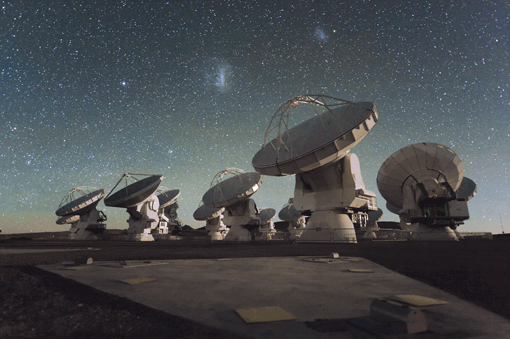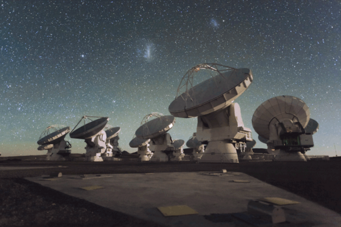A rare snapshot of a planetary construction site
Planets are formed in disks of gas and dust around nascent stars. Now, combined observations with the compound telescope ALMA and the Herschel Space Observatory have produced a rare view of a planetary construction site in an intermediate state of evolution: Contrary to expectations, the disk around the star HD 21997 appears to contain both primordial gas left over from the formation of the star itself and dust that appears to have been produced in collisions between planetesimals – small rocks that are the building blocks for the much larger planets. This is the first direct observation of such a "hybrid disk", and likely to require a revision of current models of planet formation.
| Background information | Questions & Answers | Image download |

Abbildung 1: ALMA-Bilder der Scheibe um HD 21997. Das linke Bild zeigt die Strahlung, die von kalten Staubkörnern ausgesandt wird, die einen Ring rund um den Stern bilden. Das mittlere Bild zeigt die Strahlung, die von Kohlenstoffmonoxid ausgesandt wird. Offenbar ist das Gas auch deutlich dichter am Stern zu finden als der Staub. Das rechte Bild zeigt die Geschwindigkeitsverteilung des Gases. Die rötlichen Anteile zeigen Scheibenregionen, die sich von uns entfernten; die bläulich eingefärbten kommen auf uns zu. Die Verteilung zeigt an, dass das Gas um den Stern in seiner Mitte kreist.
When a star similar to our Sun is born, it is surrounded by a disk of dust and gas. Within that disk, the star's planetary system begins to form: The dust grains stick together to build larger, solid, kilometer-sized bodies known as planetesimals. Those either survive in the form of asteroids and comets, or clump together further to form solid planets like our Earth, or the cores of giant gas planets.
Current models of planet formation predict that, as a star reaches the planetesimal stage, the original gas should quickly be depleted. Some of the gas falls into the star, some is caught up by what will later become giant gas planets like Jupiter, and the rest is dispersed into space, driven by the young star's intense radiation. After 10 million years or so, all the original gas should be gone.
But now a team of astronomers from the Netherlands, Hungary, Germany, and the US has found what appears to be a rare hybrid disk, which contains plenty of original gas, but also dust produced much later in the collision of planetesimals. As such, it qualifies as a link between an early and a late phase of disk evolution: the primordial disk and a later debris phase.
The astronomers used both ESA's Herschel Space Observatory and the compound telescope ALMA in Chile to study the disk around the star HD 21997, which lies in the Southern constellation Fornax, at a distance of 235 light-years from Earth. HD 21997 has 1.8 times the mass of our Sun and is around 30 million years old.
The Herschel and ALMA observations show a broad dust ring surrounding the star at distances between about 55 and 150 astronomical units (one astronomical unit is the average Earth-Sun distance). But the ALMA observations also show a gas ring. Surprisingly, the two do not coincide: "The gas ring starts closer to the central star than the dust," explains Ágnes Kóspál from ESA, principal investigator of the ALMA proposal. "If the dust and the gas had been produced by the same physical mechanism, namely by the erosion of planetesimals, we would have expected them to be at the same location. This is clearly not the case in the inner disk."
Attila Moór from Konkoly Observatory adds: "Our observations also showed that previous studies had grossly underestimated the amount of gas present in the disk. Using carbon monoxide as a tracer molecule, we find that the total gas mass is likely to amount to between 30 and 60 times the mass of the Earth." That value is another indication that the gas disk is made of primordial material – gas set free in collisions between planetesimals could never explain this substantial quantity.
Thomas Henning from the Max-Planck Institute for Astronomy says: "The presence of primordial gas around the 30 million-year-old star HD 21997 is puzzling. Both model predictions and previous observations show that the gas in this kind of disk around a young star should be depleted within about 10 million years."
The team is currently working on finding more systems like HD 21997 for further studies of hybrid disks, and to find out how they fit within the current paradigm of planet formation – or the ways in which the models need to be changed.
Background information
The results described here are published in two papers in the Astrophysical Journal: Kóspál et al.: "ALMA observations of the molecular gas in the debris disk of the 30 Myr old star HD 21997" and Moór et al.: "ALMA continuum observations of a 30 Myr old gaseous debris disk around HD 21997".
• ADS entry of the article
• ADS entry by Moór et al.
The team members are Ágnes Kóspál (ESA), Attila Moór, Péter Ábrahám, Csaba Kiss, and Krisztina Gabányi (Konkoly Observatory), Attila Juhász and Markus Schmalzl (Leiden Observatory), Thomas Henning (MPIA), Dániel Apai and Ilaria Pascucci (University of Arizona), Timea Csengeri (MPIfR), Carol Grady (NASA Goddard and Eureka Scientific), and Meredith Hughes (Wesleyan University).
Herschel is an ESA space observatory with science instruments provided by European-led Principal Investigator consortia and with important participation from NASA.
The Atacama Large Millimeter/submillimeter Array (ALMA), an international astronomy facility, is a partnership of Europe, North America and East Asia in cooperation with the Republic of Chile. ALMA is funded in Europe by the European Southern Observatory (ESO), in North America by the U.S. National Science Foundation (NSF) in cooperation with the National Research Council of Canada (NRC) and the National Science Council of Taiwan (NSC) and in East Asia by the National Institutes of Natural Sciences (NINS) of Japan in cooperation with the Academia Sinica (AS) in Taiwan. ALMA construction and operations are led on behalf of Europe by ESO, on behalf of North America by the National Radio Astronomy Observatory (NRAO), which is managed by Associated Universities, Inc. (AUI) and on behalf of East Asia by the National Astronomical Observatory of Japan (NAOJ). The Joint ALMA Observatory (JAO) provides the unified leadership and management of the construction, commissioning and operation of ALMA.
Questions and Answers
What telescopes were used to obtain these results?
The observations of HD 21997 used two of the most sensitive instruments ever built to detect far-infrared and millimeter-wave radiation: The PACS and SPIRE instruments aboard ESA's Herschel Space Observatory were used to measure radiation emitted by the dust. The Herschel measurements revealed that the typical temperature of the dust grains, which range in size between several micrometers and a few millimeters, is about 60 Kelvin (-210 degree Celsius).
The Atacama Large Millimeter/submillimeter Array (ALMA), which combines the signals from a network of radio antennas, made it possible to spatially resolve the emission of both the dust grains and the gas molecules. This is how the astronomers were able to show that the dust and gas disk have different structures – evidence that they are not both the result of colliding planetesimals.
What is new/important about these results?
In many evolved systems, the collisions of planetesimals produce fresh dust that forms a tenuous disk around the star. According to the current paradigm, these so-called debris disks should be practically free of gas. Thus, it was a surprising discovery when a handful of debris disk systems – β Pictoris, HD 32297, 49 Ceti, HD 172555, HD 32297 – were found to host small amounts of gas as well. The origin of gas in these disks was the subject of lively debate: it could have been continuously produced from the planetesimals, just like the debris dust, or it could be leftover material from the primordial disk that survived for much longer than expected. The new results from the disk of HD 21997 strongly suggest leftover gas from a primordial disk: For one, the dust disk and the gas disk do not coincide, as one would expect if both had been produced as debris from planetesimal collisions. Also, the total gas mass is too large to have been produced in such collisions. With this discovery, the discussion enters a new stage. Now, the scientists will need to take a closer look at how to reconcile current models with the unexpected longevity of primordial gas.
How was the disk gas mass estimated?
When it comes to mass estimates for interstellar matter, molecular clouds and the circumstellar disks around young stars, hydrogen is the most abundant molecule. Unfortunately, hydrogen is practically inaccessible to direct observation (lack of permanent dipole moment). On the other hand, hydrogen in these situation is usually accompanied by other molecules in minute amounts. These can be used as tracers. Carbon monoxide, for instance, has several spectral lines falling conveniently in the millimeter wavelength range, where they can be observed with telescopes like ALMA. Detect carbon monoxide and, using empirical conversion formulae, you can estimate the amount of hydrogen molecules present.
For HD 21997, it had long been known that the star has a debris disk, because the thermal emission of the dust grains was detected in infrared light. Carbon monoxide was not detected until 2011, by the same team whose research is described here. This is when HD 21997 became particularly interesting to the astronomical community.
A surprising part of the new results reported here is that the researchers detected not only normal carbon monoxide (CO), but also its less abundant isotopologues – molecules containing carbon or oxygen atoms whose atomic nuclei have more neutrons than is usual. In the original estimate (Moor et al. 2011), the researchers had assumed that they were "seeing" contributions from all the molecules in the disk, and that the disk was transparent to those molecules' radiation. The detection of the much rarer isotopologues invalidates that assumption: If such rare varieties of molecules are sufficiently abundant as to be detectable, the total CO mass must be much higher than originally estimated. Evidently, the disk is opaque for normal CO, after all. An estimate using the rarest of the isotopologues detected, C18O, shows that the original estimate of carbon monoxide gas in the disk must have been too low by a factor of the order 100. The more precise estimate puts the amount of carbon monoxide at 0.06 Earth masses, and the estimate for the total mass of the gas, including hydrogen, at 30-60 Earth masses. The dust ring weighs one tenth of the Earth's mass, distributed in small dust grains that have sizes between several micrometer and a few millimeter.



Download area


- JPG RGB 510 x 510 pxl 40.47 kB
- TIF RGB 1153 x 1153 pxl 272.69 kB
- JPG RGB 1200 x 1200 pxl 134.78 kB
- JPG RGB 1800 x 1800 pxl 231.87 kB

- TIF RGB 1150 x 1150 pxl 247.24 kB
- JPG RGB 510 x 510 pxl 38.96 kB
- JPG RGB 1200 x 1200 pxl 128.84 kB
- JPG RGB 1800 x 1800 pxl 219.21 kB

- JPG RGB 510 x 449 pxl 35.55 kB
- PDF RGB 245.62 kB
- JPG RGB 800 x 705 pxl 63.19 kB
- JPG RGB 1200 x 1057 pxl 106.99 kB











